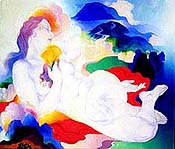i hope you like it… enjoi
epic lefts at mangrove point (36"x18"x1/2")

and the right breaks at secret spot (36"x21"x3/4")

i hope you like it… enjoi
epic lefts at mangrove point (36"x18"x1/2")

and the right breaks at secret spot (36"x21"x3/4")

Nice! A little different style and use of color than most of the surf related art on the market these days. Keep it up!
a haiku 4 u
wow that is insane
love the texture in the sun
and those waves look rad
Dayum bigrick – you’ve got some great skills. The colors are beautiful. Two thumbs up.
Nice.
The colors remind me of a “Synchromist” painting in the collection of the Santa Barbara Museum by Stanton MacDonald Wright:

Synchromism From Wikipedia, the free encyclopedia

 Stanton MacDonald-Wright, Airplane Synchromy in Yellow-Orange, 1920, oil on canvas, Metropolitan Museum of Art, New York
Stanton MacDonald-Wright, Airplane Synchromy in Yellow-Orange, 1920, oil on canvas, Metropolitan Museum of Art, New York
Synchromism was an art movement founded in 1912 by American artists Stanton MacDonald-Wright and Morgan Russell.
Synchromism is based on the idea that color and sound are similar phenomena, and that the colors in a painting can be orchestrated in the same harmonious way that a composer arranges notes in a symphony. Macdonald-Wright and Russell believed that by painting in color scales, their work could evoke musical sensations.
The abstract “synchromies” are based on color scales, using rhythmic color forms with advancing and reducing hues. They typically have a central vortex and explode in complex color harmonies.
The first synchromist painting, Russell’s Synchromy in Green, exhibited at the Paris Salon des Indépendants in 1913. Later that year, the first synchromist exhibition by Macdonald-Wright and Russell was shown in Munich. Next were exhibits in Paris and, the following year, in New York.
These synchromies are some of the first abstract non-objective paintings in American art, and became the first American avant-garde art movement to gain international attention.
The multicolored shapes of synchromist paintings often resembled those found in orphism, but MacDonald-Wright insisted that synchromism was a unique art form, and “has nothing to do with orphism and anybody who has read the first catalogue of synchromism … would realize that we poked fun at orphism”.
Other American painters experimenting with synchromism included Thomas Hart Benton, Andrew Dasburg, and Patrick Henry Bruce.
from Wikipedia
[edit] ps…that was really pedantic, wasn’t it? remnants of my schoolin’ coming back to haunt me…
Great work, big rick!
Very nice, when are they gonna become inlays? Just kidding…not really.
JSS
sorry for the bump/ delayed reply… been busy…
not a promo bump at all by the way
but just wanted to say thank you for the replies and the haiku was cool
![]()
in lays???
hmmm… maybe soon???